Keep that resolution now – ask us how!
January 6, 2011

Quit smoking! Stop drinking! Earn more! Owe less! Get that degree while shedding 10 pounds of belly fat!
If these are among your New Year’s resolutions, we’d suggest one more: buyer beware. For as surely as the ball drops in Times Square, scammers are gearing up to take advantage of your good intentions.
So how can you maintain your resolve in 2011 while steering clear of pitfalls? We asked Rigo Reyes, acting director of the county’s Department of Consumer Affairs, whose experts looked at some popular resolutions and offered these tips.
 Get healthy. “We see a lot of weight-loss programs,” says Reyes, whose team recently has been forwarding complaints and inquiries to the California Medical Board about lap band surgery. But that’s just one get-healthy-quick pitch among many. Faith healers in bogus farmacias prey on Spanish-speaking consumers who want to quit drinking or smoking or overeating. And every year, Reyes says, he hears from couch potatoes who bought sales pitches from some gyms without actually reading the high-priced contracts. “People need to read the fine print and not just believe promises,” says Reyes. Short cuts are imaginary and costly. A walk around the block, on the other hand, is free.
Get healthy. “We see a lot of weight-loss programs,” says Reyes, whose team recently has been forwarding complaints and inquiries to the California Medical Board about lap band surgery. But that’s just one get-healthy-quick pitch among many. Faith healers in bogus farmacias prey on Spanish-speaking consumers who want to quit drinking or smoking or overeating. And every year, Reyes says, he hears from couch potatoes who bought sales pitches from some gyms without actually reading the high-priced contracts. “People need to read the fine print and not just believe promises,” says Reyes. Short cuts are imaginary and costly. A walk around the block, on the other hand, is free.
 Get out of debt. “This is a top priority for a lot of people in this economy,” says Reyes. But beware of credit repair scams and offers of foreclosure assistance and debt consolidation. No one can legally remove accurate information from a credit report, and if the information is inaccurate, you can get it removed for nothing. If you’re having foreclosure troubles, deal directly with the bank or get help from a HUD-approved nonprofit—don’t waste money on for-profit intermediaries. As for debt consolidation offers, Reyes says many leave consumers with high fees, unpaid debts and worse credit. Scams such as these have become so predatory that new laws have been passed to address them. Up-front fees are now illegal for credit repair, loan modification and foreclosure assistance in California. A new federal telemarketing rule also prohibits them for debt consolidation services offered through phone sales. If you really need help, Reyes says, contact the Consumer Affairs Department at (800) 593-8222 or (213) 974-1452: “We’ll help you out for free.”
Get out of debt. “This is a top priority for a lot of people in this economy,” says Reyes. But beware of credit repair scams and offers of foreclosure assistance and debt consolidation. No one can legally remove accurate information from a credit report, and if the information is inaccurate, you can get it removed for nothing. If you’re having foreclosure troubles, deal directly with the bank or get help from a HUD-approved nonprofit—don’t waste money on for-profit intermediaries. As for debt consolidation offers, Reyes says many leave consumers with high fees, unpaid debts and worse credit. Scams such as these have become so predatory that new laws have been passed to address them. Up-front fees are now illegal for credit repair, loan modification and foreclosure assistance in California. A new federal telemarketing rule also prohibits them for debt consolidation services offered through phone sales. If you really need help, Reyes says, contact the Consumer Affairs Department at (800) 593-8222 or (213) 974-1452: “We’ll help you out for free.”
 Get a job. If the jobless rate is any indication, millions of Californians share this resolution. But employment scams are already worsening life for the desperate. “A lot of them are phishing schemes and bogus mystery shopper programs—you get an email from people claiming to be ‘recruiters’ who can get you a job if you just give them your information, which then leaves you vulnerable to identity theft.” Some of these job scammers go further. They send bogus checks to people to purportedly finance their “start-up” costs. The victims are told to deposit the checks and wire back a portion to third parties. Because the law requires banks to make the funds from the deposited check available before the check completely clears, the scammers get away with the money, which the bank will try to collect from you.
Get a job. If the jobless rate is any indication, millions of Californians share this resolution. But employment scams are already worsening life for the desperate. “A lot of them are phishing schemes and bogus mystery shopper programs—you get an email from people claiming to be ‘recruiters’ who can get you a job if you just give them your information, which then leaves you vulnerable to identity theft.” Some of these job scammers go further. They send bogus checks to people to purportedly finance their “start-up” costs. The victims are told to deposit the checks and wire back a portion to third parties. Because the law requires banks to make the funds from the deposited check available before the check completely clears, the scammers get away with the money, which the bank will try to collect from you.
 Get a degree. Great resolution, but only if you can use the diploma, so look out for unaccredited and for-profit schools. “The private post-secondary bureau in the state Department of Consumer Affairs used to license these schools, but the legislation authorizing it was allowed to sunset three years ago,” says Reyes. “People are trying to re-establish it, but in the meantime, there has been a free-for-all.” If you want to take classes or get job training, he says, apply to an accredited university, enroll at a community college or check out adult education programs at your local high school. “The Evans Adult School, which is part of the Los Angeles Unified School District, has a very comprehensive program,” says Reyes, “and you don’t have to pay anything but $5 for a student I.D.”
Get a degree. Great resolution, but only if you can use the diploma, so look out for unaccredited and for-profit schools. “The private post-secondary bureau in the state Department of Consumer Affairs used to license these schools, but the legislation authorizing it was allowed to sunset three years ago,” says Reyes. “People are trying to re-establish it, but in the meantime, there has been a free-for-all.” If you want to take classes or get job training, he says, apply to an accredited university, enroll at a community college or check out adult education programs at your local high school. “The Evans Adult School, which is part of the Los Angeles Unified School District, has a very comprehensive program,” says Reyes, “and you don’t have to pay anything but $5 for a student I.D.”
Posted 12/05/11
A young man and a dream die in war
December 15, 2010
At an age when most teens still find it challenging to crawl out of bed in the morning, 17-year-old Matthew Ramsey was driven, a doer. So as he aimed toward an early graduation from high school three years ago, it surprised no one that he also decided to join a friend in the Los Angeles Sheriff Department’s Explorer Program.
What Matthew did not expect to find as member of Explorer Class 79 was his calling. After helping deputies in the Lancaster Sheriff’s Station with a variety of tasks, the Quartz Hill teenager decided he wanted to wear the department’s badge, too, as soon as he turned 21.
In the meantime, he and a buddy made a pact that they’d enlist in the Army to hone their skills and emerge as prime candidates for the Sheriff’s Academy when their military hitch was up.
For Matthew, that tour of duty ended a lifetime too soon.
Shortly after Thanksgiving, while working at an observation post in Afghanistan’s Nangarhar Province near the Pakistani border, Matthew and five of his fellow soldiers were shot and killed by a rogue Afghan Border Police officer that his unit had trusted and worked with for several months. American soldiers killed the gunman seconds later; Al-Qaeda sources claimed he had been their sleeper agent, but that could not be confirmed.
By then, Matthew was married with a 17-month-old son, Zachary. His wife, Mirella, was pregnant with their second child. But Matthew’s death resonated well beyond his grief-stricken family, sending shock waves through his hometown and the close-knit Sheriff’s Department.
“The kids who join the Explorers are generally kind of a notch above,” says Deputy Michael Kuper, who oversees the Explorer Program for the Lancaster station near Matthew’s home. Kuper says Matthew fit the mold, an eager kid who was fully committed to a program that seems anything but glamorous. Explorers assist deputies in non-hazardous law-enforcement situations that include ride-alongs, crowd control, traffic management and community events.
Matthew finished his service with the Sheriff’s Law Enforcement Explorer Program in April, 2008. After turning 18, he left for basic training.
His mother, Melissa, admits she wasn’t happy with his decision to join the Army.
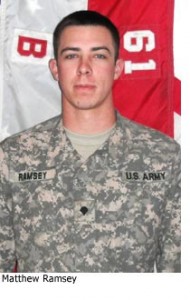 “It’s not something that we wanted,” she says. “I don’t think any parents want them to go, but we couldn’t change his mind.” While Melissa’s father, served in the U.S. Air Force, her son wasn’t raised in a military family and enlistment wasn’t a foregone conclusion. “He was my youngest, and I didn’t want him to leave. I wasn’t ready for him to go.”
“It’s not something that we wanted,” she says. “I don’t think any parents want them to go, but we couldn’t change his mind.” While Melissa’s father, served in the U.S. Air Force, her son wasn’t raised in a military family and enlistment wasn’t a foregone conclusion. “He was my youngest, and I didn’t want him to leave. I wasn’t ready for him to go.”
Still, Melissa says, “I definitely supported him and the choices he made.”
Matthew was eventually assigned to the 101st Airborne Division. In his various deployments and assignments, Matthew earned numerous citations, according to the Army, including the National Defense Service Medal, Afghanistan Campaign Medal, Global War on Terrorism Service Medal, Army Service Ribbon, Overseas Service Ribbon, NATO Medal and Air Assault Badge.
Two more will soon be added posthumously to that list: the Bronze Star and Purple Heart.
“He put 110% into everything he did,” says Melissa, whose son recently told her that he would soon be promoted to sergeant, a particular point of pride for her because of his relatively young age.
Those who knew Matthew in the Sheriff’s Department also share a sense of pride in the young man who impressed them with his sense of responsibility and enthusiasm.
As a Sheriff’s Department military liaison, Lancaster Deputy Mike Ruiz helped organize Matthew’s memorial service last Saturday at Highlands Church Fellowship, where the family worships. More than 1,000 mourners gathered.
Sending a message that life goes on, the family insisted that the church leave in place all its seasonal decorations, including a frosted Christmas tree, twinkling lights and the stage set for an upcoming Christmas musical that allowed barely enough room for all the flowers.
Melissa delivered a poem for her son, and a cousin performed a song. Speakers included the local congressman, Rep. Buck McKeon, and Brigadier General Robert B. Abrams, the commanding general for the Army’s National Training Center at Fort Irwin. Dozens of local Sheriff’s Explorers were also there, as were representatives from the Air Force and Marine Corps.
More than 100 members of the Patriot Guard Riders, a national motorcycle club whose members include former military personnel and retired police officers, helped escort the funeral cortege. A 21-gun salute was fired, taps were sounded and a precisely folded American flag was presented to the family.
Besides his wife, mother and stepfather, Matthew leaves behind an older sister, Meghan; two stepsisters, Corrin and Stephanie, and three nieces. American Security Bank in Lancaster has established the Matthew Ramsey Memorial Fund on behalf of his widow and children. Call (661) 723-2000 for further information.
Posted 12/15/10
How to book brighter future for libraries
December 2, 2010
Los Angeles County’s top librarian, Margaret Donnellan Todd, was worried about the city of Bell. Would public disgust with the salary scandal there impact the library system’s efforts to shore up its depleted finances?
The answer: “People are not mad at the libraries,” she says. “They’ve separated us from the rest of what people think about government in general now.”
That bit of much-welcomed news came during an unprecedented effort by the County Public Library to determine its long-term financial strategy at a time when its budget is strained and shrinking. The analysis, conducted by Godbe Research, showed that the public puts a premium on local libraries and would be willing to pay a special tax to keep them viable.
Based on Godbe’s research, which included extensive polling, the Library Commission this week recommended to the Board of Supervisors that the county begin aggressively examining the possibility of asking voters to pass a special parcel tax measure, which would generate millions of dollars annually. The commission also recommended that recent cuts to the library’s budget be restored.
Godbe, which was paid $42,000 for its work on behalf of the library, concluded that such a tax measure—“the only viable option”—could win the required two-thirds majority needed for passage if the amount was not too high.
Currently, unincorporated areas of the county pay a special parcel tax of $27.84 to support the libraries, as do 11 cities that opted into the library district. County libraries exist in other municipalities but residents there do not pay the parcel tax. As a result, those branches do not receive the same level of services.
Under the Library Commission’s proposal, the parcel tax, if approved, would be expanded across the Los Angeles County public library service area, more than doubling the number of parcels currently assessed with the tax.
County Librarian Todd says the document filed this week with the board provides a solid foundation to begin moving forward. She says she hopes to have Godbe conduct more polling in the spring to further gauge the mood of voters and their receptivity to a ballot measure.
“It’s important for our communities to know that this is a process,” she says, “in how to position our department for the 21st century.”
Posted 12/2/10
At the intersection of safety and tragedy
December 2, 2010
On Feb. 12, 2008, a commercial fire broke out near Compton. A Los Angeles County fire truck rushed east along 135th Street toward the scene. Lights flashing, siren blaring, the truck was doing 35 mph when the light turned red at Figueroa Street. Firefighters thought everyone had stopped or pulled over. So, downshifting, the truck rolled through the intersection en route to the emergency.
They were mistaken. A catering truck had suddenly made a left turn into the fire truck’s path. In the back of the vehicle, court documents would later show, an $80-a-day cook named Antonia Roman had just finished warming tortillas for the next stop. Unrestrained by a seat belt, she was making her way back toward her passenger seat when the crash sent the catering truck careening onto its side.
Roman, a 43-year-old mother with a 6-year-old son still at home in Montebello, was thrown from the wreckage. When she regained consciousness, she was a paraplegic. The firefighter behind the wheel, meanwhile, would later discover that, in the course of a few years, the county’s policy for negotiating intersections on emergency calls had changed without his knowledge, requiring him to come to a full stop at the light, rather than to slow to a speed that was safe for the situation.
This week, the Board of Supervisors approved a $3.3 million settlement to Roman in the case.
The incident is significant, and not only because the injuries were so tragic and the settlement so substantial. It also highlights, once again, a complex, life-and-death question that public safety workers and policymakers deal with every day: What is the safest, best way for the driver of an emergency vehicle to negotiate an intersection when lives are in the balance?
In 2008, the last year for which statistics are available, there were 340 collisions involving emergency vehicles on Code 3 calls in California, 116 of them at intersections, according to the California Highway Patrol. The collision that crippled Roman was one of 36 involving emergency vehicles in Los Angeles County intersections that year.
Although the law is clear for civilian drivers—when an emergency vehicle approaches, you stop or pull over and yield the right-of-way—answers are not as definitive for those on the other side of the lights and sirens.
The California Vehicle Code exempts emergency vehicles en route to 911 calls—fire trucks, ambulances, police cars, etc.—from many rules of the road, including those involving red lights. The sole stipulation is that that the vehicle be driven at a speed that’s safe for the road conditions and “with due regard for the safety of all persons using the highway.”
Within those parameters, however, policies vary among agencies and jurisdictions when it comes to balancing the urgency of the call against the need for safety.
“The law says you have to clear the intersection—you can’t just blow through it,” says California Highway Patrol Executive Lt. Kevin Gordon. “You have to make sure it’s safe to proceed and that other motorists are aware of your presence. But there are variances in how best to implement that.”
The policy of the Los Angeles City Fire Department, for instance, is to “stop at all red lights and stop signs . . . and when safe, proceed through the intersection with caution.” The Pasadena Fire Department’s policy does not spell out whether a full stop is required when entering an intersection against a red light. However, the department’s emergency response procedures list “driving against traffic lights” as one of a series of conditions that require “reduced speed and extra caution.”
The county’s policy, meanwhile, has gone back and forth in its attempt to maximize safety, from a 2000 policy that instructed drivers to “slow to a speed which would allow observation of approaching vehicles and pedestrians” to the policy in force at the time of the collision, which told drivers to “stop at all signal controlled intersections that display a red light . . .”
Since then, the policy has again been updated, requiring that the driver simply apply the law with caution and “clear the intersection, lane by lane, until all traffic has yielded the right of way.”
An overview presented to the Board of Supervisors in connection with the Roman case suggests that those shifts may have been confusing. Listed among the factors that “gave rise to [the] accident” was a “failure to be aware of and adhere to the current Department driving policy” on the driver’s part, and a similar failure by his captain to make him aware of the policy.
“We’re trying to learn from what happened,” says Los Angeles County Fire Chief P. Michael Freeman. The challenge, he says, is in balancing the need for swift, potentially life-saving emergency response with the need to navigate traffic safely as public safety workers rush to deliver help.
Traffic safety is crucial, he says, but bringing a heavy truck to a full stop and then getting it up to full speed again takes time when every moment counts. What’s more, he says, stopping at an intersection may confuse other drivers about whether they should stop, go or look for flames around them.
Says the chief: “It’s a question of what’s safest for the public and what’s safest for the people on the other end of the 911 call we’re trying to get to.”
Posted 12/2/10
Touring Hall of Justice, by flashlight
November 3, 2010
The temperature outside was pushing 90, but when the padlock came off the chained doors of the Hall of Justice, the air rushed out like a chilly blast from the crypt.
Inside, though, the legendary 1925 building looks like it’s starting to wake up from its big sleep.
The Hall of Justice—where Charles Manson, Bugsy Siegel, Sirhan Sirhan and a host of other big- and small-time criminals once cooled their heels, where Marilyn Monroe’s body ended up after her suicide and where Robert Mitchum once did time for marijuana possession—is one of downtown’s Los Angeles’ most striking landmarks.
Red-tagged and vacant since the 1994 Northridge earthquake, the Hall not so long ago was rat-infested, debris-ridden and home to the occasional transient.
Now its interior has been cleaned out and virtually gutted.
Later this month, the county Board of Supervisors will be asked to approve the selection of a firm to undertake the historic rehabilitation and retrofitting that will turn the site into the new headquarters for the Sheriff’s Department. Staff from the District Attorney, Public Defender and Alternate Public Defender also will be stationed in the building, located at Spring and Temple, across from the criminal courts building.
Work on the three-year project is expected to begin early next year. The approximately $244 million Hall of Justice rehabilitation, along with other capital projects, will be funded in part by “Build America” bonds whose issuance was approved by supervisors on Wednesday. The project’s cost is expected to be partly offset by lease savings for the departments that will be relocating to the building.
Alicia Ramos, who has been overseeing the Hall of Justice project for the county Department of Public Works since 2004, said that years of advance work have been devoted to “trying to create the cleanest slate we can” for the new office space interior.
On Tuesday, Ramos led a writer for Supervisor Yaroslavsky’s website and a county photographer on a flashlight-illuminated tour that started in the building’s basement and ended on its rooftop. A gallery of photos from the tour, below, offers an unusual glimpse inside the building as it awaits its transformation.
To get to this point, tons of debris—including about a half million dollars’ worth of recycled jail cell bars—have been hauled away and reams of once-confidential documents have been incinerated and sent to that great repository in the sky. (See update below.) Elevator shafts now stand empty, their vintage wood-and-brass cabs sidelined until they can be pressed back into service with a modern operating system.
All of the building’s jail cells have been ripped out. One cell block, said to have housed Manson, has been preserved and relocated to the first floor, where it eventually will be opened to the public as part of a new museum/interactive center focused on the history of the building and the sheriff’s department.
The building’s courtrooms, once the site of trials that included the Sleepy Lagoon murder case, have all been demolished except for one, which is being preserved right down to its embellished plaster corbels and will be restored and used as a sheriff’s conference room. The same goes for a wood-paneled law library nearby. Both are located on the building’s 8th floor, where the sheriff will have his office.
The plan to bring the Hall of Justice back to life includes seismic reinforcement; new electrical, plumbing and mechanical systems; a 1st floor cafeteria that will be open to the public; and a nine-level, 1,000-vehicle parking structure, half of it underground.
The building’s open lobby, or loggia—which Ramos calls “the crowning glory of the Hall of Justice’—also is awaiting restoration. Even in its current state, the loggia exudes glamour and gravitas, from its marble columns to its elaborate ceiling and chandeliers. Covered up for the moment are its terrazzo floors and historic iron-and-brass stairs.
“It’s dramatic. It’s the scale, it’s the materials,” said Ramos, 37, an architect and Cal Poly Pomona grad. “It really can take you back to a period.”
Even in its current state, the Hall—whose architectural style is variously described as Beaux Arts, Italian Renaissance or Federalist—holds no terrors for Ramos, despite its sometimes macabre past.
“I haven’t gotten any ghost stories out of this building,” she said. Those she’s heard from others can be logically explained. (Voices in the basement, for instance, are more likely coming via a closed-up tunnel from an adjoining county building, not from the spirit world beyond.)
“They’re all stories to me. I’ve never seen anything wicked or sinister,” Ramos said.
She even ventured inside the Hall alone occasionally, like the time she came inside to photograph a judicial seal inside the law library.
Later, she was there when a transient who’d been caught living in the building was escorted away by police.
The man looked at Ramos. “He said, ‘I know you. I’ve seen you walking through here.’ The hair went up on my neck.”
Nowadays, she said, “I don’t go through the building by myself.”
Up on the building’s roof—once a prison yard-style exercise area for inmates that may be turned into a jogging track for employees—Ramos reflected on everyone and everything these walls have seen.
“Between Marilyn Monroe and Charlie Manson,” she said, “it’s kind of the good and the bad that come through these kinds of facilities.”
Photos by Scott Harms/Los Angeles County
Posted 11/3/10
Updated 11/4: Regarding questions about the destruction of documents, sheriff’s officials said Thursday that they removed all records from the Hall of Justice and left behind only trash or outdated forms. Department of Public Works officials said they exercised an abundance of caution and treated all papers left behind as confidential because they were not in a position to evaluate them. They said all documents were destroyed in accordance with the county’s policy.
A push for receivership in Bell
September 21, 2010
As city leaders in Bell were being arrested Tuesday, Los Angeles County Supervisors voted to ask state Attorney General Jerry Brown to consider a range of legal actions, including moving to place the scandal-plagued city under an independent receivership.
Supervisors voted 4-0 in favor of the motion by board chair Gloria Molina. Supervisor Michael D. Antonovich was not present.
“I think we have a duty here to start sorting out what is our role and responsibility to these constituents,” Molina said before the vote. “They’re my constituents as well as this entire board’s constituency, and we’re trying to figure out how to bring order.”
The motion urged Brown to “use every legal measure at his disposal” to prevent further harm to the residents of Bell, where exorbitant salaries for public officials have prompted a public uproar, along with a series of state and local investigations into corruption and improper taxation.
Brown, who is running for governor against Meg Whitman, recently sued Bell officials for fraud and misuse of public funds.
In addition to suggesting the appointment of an independent receiver to operate the city and audit its contracts and accounts, Molina’s motion also directed the city of Bell to provide the county with $2.9 million in wrongfully-imposed taxes, so that taxpayers could be reimbursed.
Bell resident Nestor Valencia, a local activist, was among those urging supervisors to take action on Tuesday.
“Our government has let us down in the city of Bell,” he said, “and it has done so for many years.”
Residents of the city cheered as news of the arrests of current and former leaders broke, the Los Angeles Times reported.
Posted 9/21/10
Bell tax refunds not money in the bank
September 15, 2010
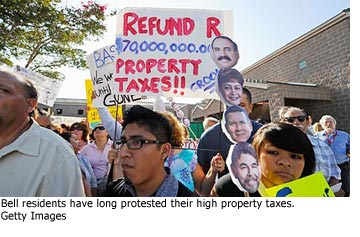 Los Angeles County’s auditor-controller has a message for the city of Bell: Show me the money.
Los Angeles County’s auditor-controller has a message for the city of Bell: Show me the money.
Late Wednesday, Wendy Watanabe urged Bell in writing to promptly transfer $2.9 million to her office so refunds can be sent to homeowners whose property taxes were illegally hiked during the past three years.
“The refund process to Bell taxpayers is a high priority for Los Angeles County…and we look forward to your cooperation,” Watanabe said in a letter to Bell’s interim city administrative officer, Pedro Carrillo.
Watanabe’s letter was prompted by a surge of calls from Bell residents this week after state legislation was signed that cleared the way for the refunds, which otherwise would have gone to the city’s schools. The callers wanted to know when the checks would be hitting their mailboxes. Their expectations were raised when the bill’s author, Assemblyman Kevin DeLeon (D-Los Angeles), said the refunds could be mailed within a week.
Watanabe said she was driving to work when she heard that hope recounted by KFI radio host Bill Handel. “I said to myself, ‘Excuse me? Are you processing the payment? Are you paying?’ I almost stopped the car and called.”
“The auditor-controller does not have the authority to front the money,” she said. “I’m sympathetic but I’m not in any position to do so.”
Put another way by Watanabe’s top aide on the issue, Arlene Barrera: “We don’t have money just sitting around.”
Under the new law—signed Monday by Lt. Gov. Abel Maldonado because Gov. Arnold Schwarzenegger was in Asia—Bell has until December 31 to transfer the funds to the county. The auditor-controller’s office, however, has been pushing behind the scenes for a faster resolution to help Bell’s homeowners, who’ve been complaining for years of exorbitant property taxes.
In fact, despite Bell’s largely lower-income population, its tax rate is the second highest in L.A. County—higher even than Beverly Hills. (See earlier story here on Bell’s attempts to undermine a resident’s meeting with county officials.)
The resident’s complaints finally got traction in July, when the Los Angeles Times revealed the scandalously high salaries of Bell officials, prompting a number of official investigations, including one by State Controller John Chiang. He determined, among other things, that Bell homeowners for the last three years had been charged for pension obligations that exceeded the legal limits.
In her letter to Bell, Watanabe said her office had thus far identified 4,772 Bell residents who continuously owned homes and paid property taxes during the past three years, making them eligible for full refunds of the unlawful levied charges. The remaining 1,258 properties, she said, have changed ownership during that period, meaning that the refunds will have to be pro-rated between the current and previous owners.
So far, despite official and back-channel conversations, Bell has yet to tell the auditor-controller’s office when to expect the $2.9 million.
“They said they’d let us know as soon as possible,” Barrera said.
Posted 9/15/10
Who’s making what?
August 26, 2010
 Starting this week, the salaries of roughly three dozen Los Angeles County executives who head agencies as obscure as the office of Military and Veterans Affairs and as massive as the Department of Public Social Services can be viewed online for the first time.
Starting this week, the salaries of roughly three dozen Los Angeles County executives who head agencies as obscure as the office of Military and Veterans Affairs and as massive as the Department of Public Social Services can be viewed online for the first time.
The action came after the Board of Supervisors two weeks ago unanimously approved a motion by Supervisor Zev Yaroslavsky aimed at increasing transparency in the wake of the city of Bell salary scandal. The salaries of the county’s elected officials have long been a matter of public record, as have salary ranges for all job classifications within the bureaucracy. (Members of the Board of Supervisors make $178,789 a year.)
Topping the newly posted list of board-appointed officials is Chief Executive Officer William T Fujioka, with an annual salary of $338,458. He’s followed by the director of the Department of Public Health, Dr. Jonathan Fielding, whose annual salary is $309.494.
The complete list can be seen here and accessed through county’s main website.
Posted 8/25/10
NeverWonderLand 2010
August 12, 2010
 “NeverWonderLand” imagines a kind of mash-up between Lewis Carroll’s “Alice in Wonderland” and J.M. Barrie’s “Peter Pan.” Yet it’s also a wholly original dance story (trailer here) inspired by the Victorian children’s classics. And the work, brought to you by Boom Kat Dance Theatre, serves as a kind of prequel successfully melding these celebrated tales of the childhood journey from innocence to experience.
“NeverWonderLand” imagines a kind of mash-up between Lewis Carroll’s “Alice in Wonderland” and J.M. Barrie’s “Peter Pan.” Yet it’s also a wholly original dance story (trailer here) inspired by the Victorian children’s classics. And the work, brought to you by Boom Kat Dance Theatre, serves as a kind of prequel successfully melding these celebrated tales of the childhood journey from innocence to experience.
“NeverWonderLand” explores two iconic visions of youthful exploration and adolescent fear as Peter and Alice, brother and sister, seek a place in their lives in that mysterious zone between imagination and reality as they depart their familiar London on a voyage to—NeverWonderLand.
But this production is no museum piece or Walt Disney retread. Infused with a blast of modern magic, we’re offered skinny jeans-clad Lost Boys and a life-sized Tinkerbell. Yet the timeless challenges remain for these young people: how to make friends, deal with menacing enemies, and eventually to grow up. See how the siblings Peter and Alice struggle to find the balance between fantasy and reality, reconcile the pressure for social conformity with personal desire, and navigate the perilous tightrope between childhood and adulthood.
“NeverWonderLand” returns after a sold-out run in 2009, so be sure not to miss it. The production only runs through August 22 at the Miles Memorial Playhouse, 1130 Lincoln Blvd. in Santa Monica. Get your tickets online, and call 310-202-9229 for further information.




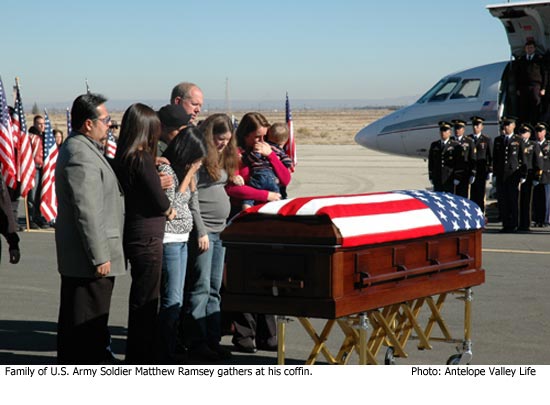


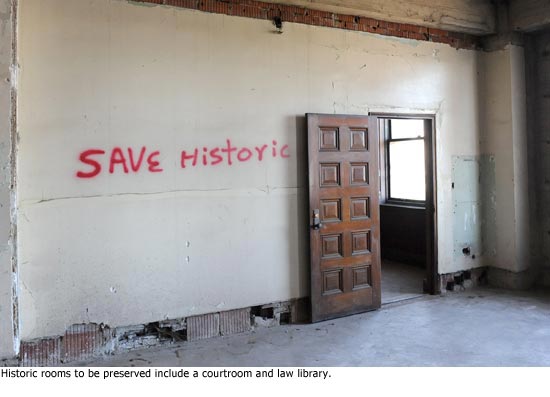
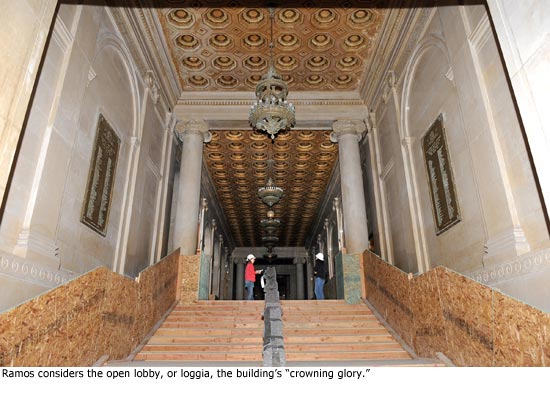















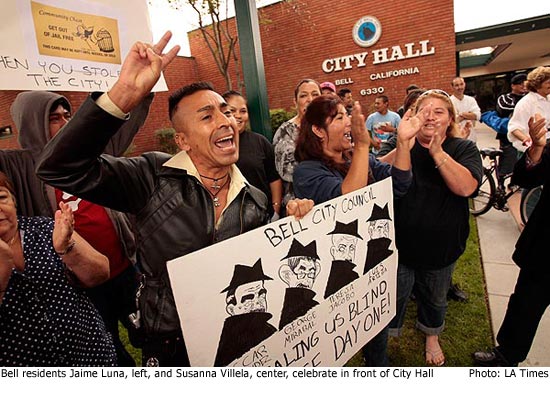







 405 bridge work causes a stink
405 bridge work causes a stink

